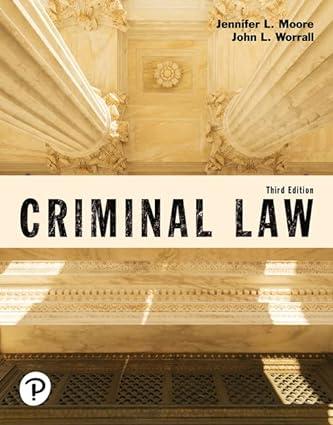Question
1: In which case concerning the freedom of speech did Justice Oliver Wendell Holmes famously argue that the First Amendment wouldn't protect somebody yelling fire
1: In which case concerning the freedom of speech did Justice Oliver Wendell Holmes famously argue that the First Amendment wouldn't protect somebody yelling "fire" in a crowded theater?
2: When Schenck and Baer sent literature to WWI soldiers which argued that the military draft was a form of involuntary servitude they were indicted under what free-speech-limiting law?
3: Which judicial "test" did the court apply in Gitlow v. New York to uphold New York's Criminal Anarchy Law of 1902 so they could prosecute a person who distributed socialist pamphlets?
4: In which free speech case was Holmes' "clear and present danger" test reconsidered - leading the Supreme Court to argue that speech advocating illegal conduct is protected under the First Amendment unless the speech is likely to incite "imminent lawless action"?
5: In which Supreme Court case did Justice Louis D. Brandeis argue that California's Criminal Syndicalism Act of 1919 violated a person's free speech rights by creating guilt-by-association with a remote connection to a doctrine that may, in some future time, threaten the public order?
6: In which landmark free speech case was a major, national newspaper sued by a city commissioner from Montgomery, Alabama for minor factual errors in a civil rights fundraising editorial advertisement?
7: What legal test did the Supreme Court develop in the case mentioned in the previous question which argued that no public official could win damages for libel without proving that the statement was made "with knowledge that it was false or with reckless disregard of whether it was false or not"?
8: What latin-named legal principle was established in the case from the previous two questions which meant that the Supreme Court would itself determine how legal principles or tests would apply to a case rather than sending the case back to lower courts so they could determine how such principles and tests should be applied?
9: What Supreme Court case made international news when the court ruled that a major newspaper could publish classified government documents concerning the Vietnam War despite President Nixon's claim that publishing would violate national security?
10: In the case mentioned above, which Supreme Court justice unequivocally sided with the newspaper and argued that "only a free and unrestrained press can effectively expose deception in government"?
11: What Supreme Court case caused widespread public outrage because it was seen to allow corporations to be considered as having the same legal rights as flesh-and-blood people while also equating money with speech?
12: In the case mentioned in the previous question, which Supreme Court justice stated that, "We find no basis for the proposition that, in the context of political speech, the Government may impose restrictions on certain disfavored speakers," and added that "the First Amendment does not allow political speech restrictions based on a speaker's corporate identity"?
13: In the same case mentioned above, which dissenting Supreme Court justice argued that the majority decision was "profoundly misguided" and that the "ruling threatens to undermine the integrity of elected institutions across the Nation"?
14: In what controversial 2011 case did the Supreme Court rule eight- to-one that members of the Westboro Baptist Church were lawfully exercising their First Amendment rights when they picketed the funerals of military service-members in order to protest American toleration of homosexuality?
15: Name the current Chief Justice of the Supreme Court whose majority opinion in the case mentioned in question 19 wrote that: "Speech is powerful. It can stir people to action, move them to tears of both joy and sorrow, and - as it did here - inflict great pain. On the facts before us, we cannot react to that pain by punishing the speaker. As a Nation we have chosen a different course - to protect even hurtful speech on public issues to ensure that we do not stifle public debate."
16: Name the first Chief Justice of the Supreme Court who also helped author the Federalist Papers?
17: When was the Supreme Court first established?
18: Though the Supreme Court now features nine Justices, how many Justices originally composed the Court when it was first established?
19: Which of the original first two amendments in the Bill of Rights (that were not ratified, thus making the current First Amendment the originally proposed Third Amendment) was eventually adopted in 1992 as the 27th Amendment?
20: Who is the current, longest-serving Justice on the Supreme Court?
Step by Step Solution
There are 3 Steps involved in it
Step: 1
Answer 1 Justice Oliver Wendell Holmes famously argued that the First Amendment wouldnt protect somebody yelling fire in a crowded theater in the case Schenck v United States 1919 2 Schenck and Baer w...
Get Instant Access to Expert-Tailored Solutions
See step-by-step solutions with expert insights and AI powered tools for academic success
Step: 2

Step: 3

Ace Your Homework with AI
Get the answers you need in no time with our AI-driven, step-by-step assistance
Get Started


